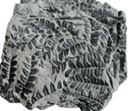The plant world
Plants, although mainly made of soft tissue, left traces of their evolution in the fossil record just like animals. In particular, the great humid forests of the Carboniferous Period, known as the Age of Coal, provide us with many excellent examples of fossilized plants worldwide.

 (120 kb)Before becoming widespread on land, plants first made their appearance in water. More than 3.5 billion years ago (3.5 Ga), small single-celled organisms acquired the capacity to photosynthesize, meaning they could use the energy of the sun to produce glucose from carbon dioxide with free oxygen (O2) as a waste product. Free oxygen was rare when the Earth was young, but gradually accumulated, thanks to photosynthesis, until reaching 20% of the air we breathe today.
(120 kb)Before becoming widespread on land, plants first made their appearance in water. More than 3.5 billion years ago (3.5 Ga), small single-celled organisms acquired the capacity to photosynthesize, meaning they could use the energy of the sun to produce glucose from carbon dioxide with free oxygen (O2) as a waste product. Free oxygen was rare when the Earth was young, but gradually accumulated, thanks to photosynthesis, until reaching 20% of the air we breathe today.
These first photosynthesizing organisms, cyanobacteria, later gave rise to algae, the first aquatic plants. Plants were restricted to the aquatic world until three billion years later, at the end of the Ordovician period, when we find signs of their tentative presence on land. After many more millions of years, they resembled patches of moss a few centimeters high. But things changed in the Devonian Period, and these primitive plants finally developed many of the more familiar characteristics of modern day land plants.

 (120 kb)Before becoming widespread on land, plants first made their appearance in water. More than 3.5 billion years ago (3.5 Ga), small single-celled organisms acquired the capacity to photosynthesize, meaning they could use the energy of the sun to produce glucose from carbon dioxide with free oxygen (O2) as a waste product. Free oxygen was rare when the Earth was young, but gradually accumulated, thanks to photosynthesis, until reaching 20% of the air we breathe today.
(120 kb)Before becoming widespread on land, plants first made their appearance in water. More than 3.5 billion years ago (3.5 Ga), small single-celled organisms acquired the capacity to photosynthesize, meaning they could use the energy of the sun to produce glucose from carbon dioxide with free oxygen (O2) as a waste product. Free oxygen was rare when the Earth was young, but gradually accumulated, thanks to photosynthesis, until reaching 20% of the air we breathe today. These first photosynthesizing organisms, cyanobacteria, later gave rise to algae, the first aquatic plants. Plants were restricted to the aquatic world until three billion years later, at the end of the Ordovician period, when we find signs of their tentative presence on land. After many more millions of years, they resembled patches of moss a few centimeters high. But things changed in the Devonian Period, and these primitive plants finally developed many of the more familiar characteristics of modern day land plants.
Site map | Feedback | Links | Sources | Credits
The plant world
<< The Late Devonian extinction event | The conquest of land >>



